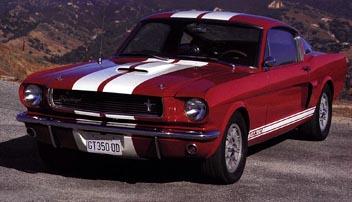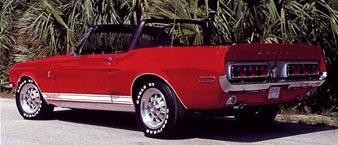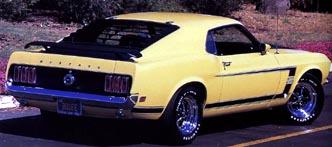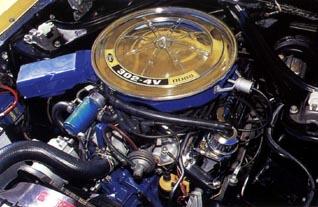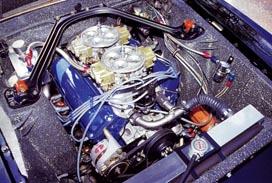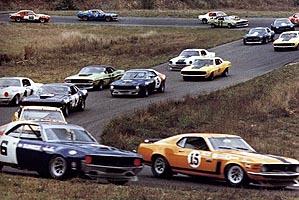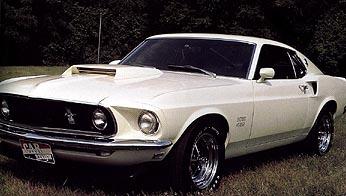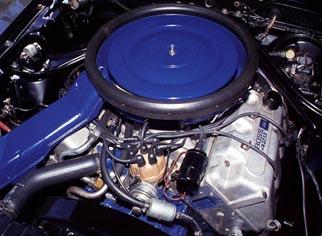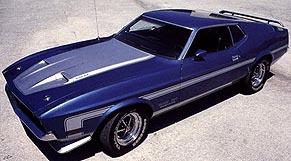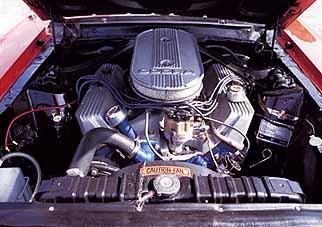|
|
||||||||||
A Little History On The Shelby's, Boss's, & Cobra JetsShelby GT350With the introduction of the Falcon-based Mustang Ford wanted to show that the car really was a sports car by racing. Unfortunately, Ford had gotten out of all factory-backed racing in 1957. After Iacocca became Ford GM in 1960 he met Carroll Shelby for the first time. Shelby was building a sports car in California and got agreement to use Ford's small block V8 for the project. Again in 1964 Ford came to Shelby to help "hot rod" the new Mustang. The idea was to compete in SCCA road racing. The GT350 was born and it dominated SCCA B/Production winning the championship three years in a row. This gave Ford the sporty image they were looking for. The SCCA started a new series for American production-based sedans called the Trans-American Sedan Championship. Shelby was again called on to provide the racecar building experience.
Shelby GT500In 1968 production of the Shelby cars shifted from his California site to the Midwest and more under Ford's control. The '68 car used a slightly modified version of the 428 Police Interceptor motor, and even a few had 390s due to a lack of available 428s. These cars still lost the drag strip wars to the top-of-the-line 396 Camaros. Later in 1968 the Cobra Jet motor became available in the model called the GT500KR. Only 1,314 were made in '68 including 381 convertibles. 1969 was the last year for Shelby production, although some of the cars were unsold by year-end and were then sold as 1970 vehicles.
Boss 302Starting with the 1969 model year the Ford brought the road racing Mustang program in house by creating the Boss 302 with styling by Larry Shinoda, suspension by specialty builder Kar Kraft, and engine by Ford using the 5.0L block with the new 351 Cleveland heads. The car was originally to be called the Trans Am until Ford found out GM had already licensed the name from the SCCA. The Boss 302 was rated at 290 HP because insurance companies were beginning to penalize the muscle cars by tacking on higher charges to any car rated over 300 HP. Actual horsepower was closer to 350. (These are Gross HP figures, not Net, as used today). Race versions made 450 HP at over 8,000 RPMs. Boss 302s also ran in Nascar's Grand American (GA) series. The car came with a wide-ratio or close-ratio 4-speed top loader. A 3.50:1 rear gear was standard with 3.91 and 4.30 optional. Front discs are rear drum brakes and 15-inch wheels were standard. Road tests at the time put 1/4-mile performance in the upper 14-second range. However, Super Stock magazine tweaked a '70 Boss 302 and put slicks on to get a time in the mid-13s. In late 1970 Ford stopped all factory-sponsored racing.
Boss 429The Boss 429 was built in response to Chrysler's 426 Hemi and it's success in Nascar. Ford built a 427 Hemi-headed single overhead cam motor first, but it wasn't considered stock enough for the series so along came the "semi-Hemi" head 429. The task of wedging a 429 into the Mustang was given to Kar Kraft. Quarter-mile times were reported to be in the lower 14s. Although another of the hot rod magazines, Car Craft, slightly modified the stock 429 and got a 1/4 mile in the mid 12s. The street cars came from the factory with a conservative cam and a somewhat small carburetor.
Boss 351The Boss 351 engine used the Cleveland block with the heads from the Boss 302. It came with a 4-speed and a 3.91:1 rear axle and still with rear drum brakes. The engine was available in the newly redesigned '71 Mustang that weighed over 3800 lbs., about 300 more than a Boss 302. Road tests at the time returned 1/4 mile ET's in the low 14s, although it was hard to get accurate times because Ford had shipped "specially modified" cars to the testers of most magazines that ran much quicker. This seemed to be a fairly common practice in the muscle car days when quarter-mile times related directly to sales.
428 Cobra JetWhen the big blocks hit the pony cars in '67 with the 390 Mustang and the 396 Camaro Ford was caught on the short end of the muscle car wars. The 396 was about a second quicker in the quarter mile than the 390. Shelby was the first to offer competition with the 428-powered GT500, but this was still a bit slower than the Camaro. It was actually a Ford dealer and drag racer named Bob Tasca who solved the problem by bolting 427 heads on the 428. These free-flowing heads combined with the torquey 428 really made the car move. Soon Ford had their own version, the 428 Cobra Jet. This put 1/4-mile times at about 14 seconds. This engine was first available in 1967 1/2 as a $420 option. About 2,800 were sold in late '67, 13,000 in '69 and 2,700 in '70.
429 Cobra JetThis engine option was available only in 1971 with 370 HP and a 1/4-mile time of about 14 seconds. Only 1,300 were sold. This was the end of the muscle car era for the Mustang as low compression engines came in to use for the "bad old days" of the '70s.
Ford Mustang Engine History Click Here
Mustang History From The Early Day Click Here
If You Would Like Us To Custom Build You An Engine Call For Immediate Assistance
1-800-267-3940 23 Cindy Lane Ocean, NJ 07712
Major Credit Cards Accepted
Call Toll Free 24 Hrs. 1-800-267-3940 1-732-695-2525 Fax info@Pro-formanceunlimited.com Copyright © 2006 Pro-formance Unlimited Inc.
Web Authoring by Oger's Web
Design
|

